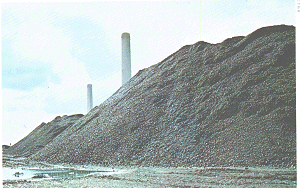
 |
How it works : Mass-Energy Equivalence |
MASS-ENERGY EQUIVALENCE
One of the most far-reaching results of Einstein's 1905 Special Theory of RELATIVITY is the one which states that mass and energy are equivalent. Mathematically, this is the famous statement E= mc2 the total energy contained in a piece of matter is given by its mass multiplied by the square of the speed of light.
 |
This power station has coal stocks of 140,000 tons, capable of producing 260,000 megawatt hours of electricity in the normal way. If it could be completely converted into energy, however, it would produce 4000 million million MWh of energy -enough to supply the world's current energy demands for another 30,000 years. |
Einstein arrived at this conclusion from the basic assumption that the velocity of LIGHT is the same for any observer, what ever his velocity relative to the source of light. This goes against everyday experience, yet it is supported by every test that scientists have applied. Einstein's predictions, made from this assumption, are equally unexpected yet have nevertheless been supported by experiment-the most dramatic example being that of the A-BOMB, which uses the FISSION of a uranium isotope.
Although the equivalence of mass and energy is generally accepted, the problems of actually extracting the energy from matter are immense. The Sun, or an H-BOMB, uses FUSION of hydrogen atoms to make helium atoms, the difference between four hydrogen atoms and one helium atom being released as energy. This process is much more efficient than that of fission, yet if the difference between the two masses is compared with the total mass, it turns out that in the fusion process only 0.7 % of the available energy is released.
Astrophysicists and nuclear scientists are equally interested in the problem of extracting as much energy as possible, and have suggested further processes which may work. By pouring matter down a black hole, that is a region in space where the matter is so condensed that nothing, not even light, can escape from it, it may be possible to extract as much as 43% of the rest mass of a particle as energy-the particle gives out radiation as it accelerates. No black holes are so far definitely known to exist, though there is no theoretical objection to them. But the only way of converting 100% of the rest mass into energy appears to be complete annihilation of matter by allowing it to meet antimatter.
Small amounts of antimatter-positrons, or anti-electrons- have been created,
and when these interact with ordinary matter, all their mass indeed appears
as energy. But the antimatter had to be created in the first place, causing
an original loss of the same amount of energy. No reserves of antimatter
are known in the universe, and unless some are found, it appears that the
dream of completely converting a small amount of matter into enough energy
to meet all of mankind's needs must remain an impossible one.
Reproduced from HOW IT WORKS p1463